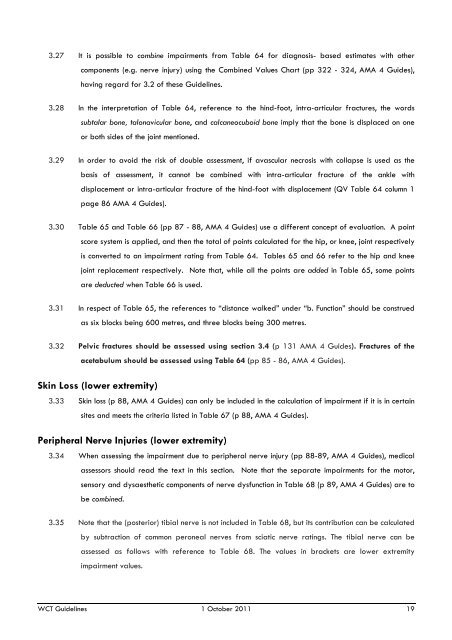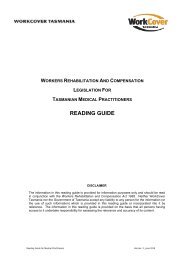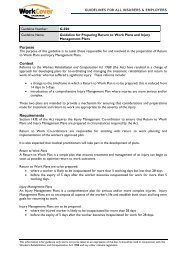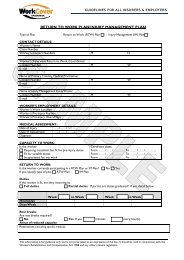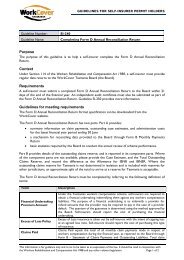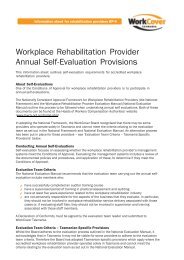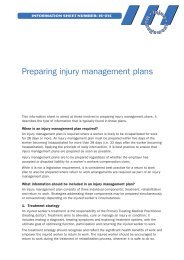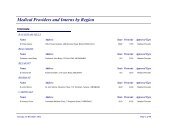Guidelines for the assessment of permanent impairment Version 3
Guidelines for the assessment of permanent impairment Version 3
Guidelines for the assessment of permanent impairment Version 3
You also want an ePaper? Increase the reach of your titles
YUMPU automatically turns print PDFs into web optimized ePapers that Google loves.
3.27 It is possible to combine <strong>impairment</strong>s from Table 64 <strong>for</strong> diagnosis- based estimates with o<strong>the</strong>rcomponents (e.g. nerve injury) using <strong>the</strong> Combined Values Chart (pp 322 - 324, AMA 4 Guides),having regard <strong>for</strong> 3.2 <strong>of</strong> <strong>the</strong>se <strong>Guidelines</strong>.3.28 In <strong>the</strong> interpretation <strong>of</strong> Table 64, reference to <strong>the</strong> hind-foot, intra-articular fractures, <strong>the</strong> wordssubtalar bone, talonavicular bone, and calcaneocuboid bone imply that <strong>the</strong> bone is displaced on oneor both sides <strong>of</strong> <strong>the</strong> joint mentioned.3.29 In order to avoid <strong>the</strong> risk <strong>of</strong> double <strong>assessment</strong>, if avascular necrosis with collapse is used as <strong>the</strong>basis <strong>of</strong> <strong>assessment</strong>, it cannot be combined with intra-articular fracture <strong>of</strong> <strong>the</strong> ankle withdisplacement or intra-articular fracture <strong>of</strong> <strong>the</strong> hind-foot with displacement (QV Table 64 column 1page 86 AMA 4 Guides).3.30 Table 65 and Table 66 (pp 87 - 88, AMA 4 Guides) use a different concept <strong>of</strong> evaluation. A pointscore system is applied, and <strong>the</strong>n <strong>the</strong> total <strong>of</strong> points calculated <strong>for</strong> <strong>the</strong> hip, or knee, joint respectivelyis converted to an <strong>impairment</strong> rating from Table 64. Tables 65 and 66 refer to <strong>the</strong> hip and kneejoint replacement respectively. Note that, while all <strong>the</strong> points are added in Table 65, some pointsare deducted when Table 66 is used.3.31 In respect <strong>of</strong> Table 65, <strong>the</strong> references to “distance walked” under “b. Function” should be construedas six blocks being 600 metres, and three blocks being 300 metres.3.32 Pelvic fractures should be assessed using section 3.4 (p 131 AMA 4 Guides). Fractures <strong>of</strong> <strong>the</strong>acetabulum should be assessed using Table 64 (pp 85 - 86, AMA 4 Guides).Skin Loss (lower extremity)3.33 Skin loss (p 88, AMA 4 Guides) can only be included in <strong>the</strong> calculation <strong>of</strong> <strong>impairment</strong> if it is in certainsites and meets <strong>the</strong> criteria listed in Table 67 (p 88, AMA 4 Guides).Peripheral Nerve Injuries (lower extremity)3.34 When assessing <strong>the</strong> <strong>impairment</strong> due to peripheral nerve injury (pp 88-89, AMA 4 Guides), medicalassessors should read <strong>the</strong> text in this section. Note that <strong>the</strong> separate <strong>impairment</strong>s <strong>for</strong> <strong>the</strong> motor,sensory and dysaes<strong>the</strong>tic components <strong>of</strong> nerve dysfunction in Table 68 (p 89, AMA 4 Guides) are tobe combined.3.35 Note that <strong>the</strong> (posterior) tibial nerve is not included in Table 68, but its contribution can be calculatedby subtraction <strong>of</strong> common peroneal nerves from sciatic nerve ratings. The tibial nerve can beassessed as follows with reference to Table 68. The values in brackets are lower extremity<strong>impairment</strong> values.WCT <strong>Guidelines</strong> 1 October 2011 19


